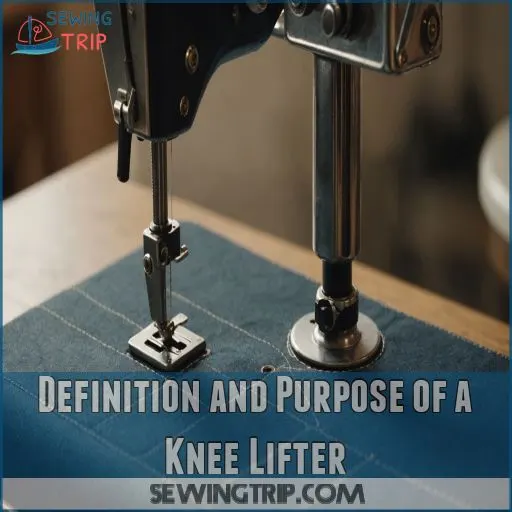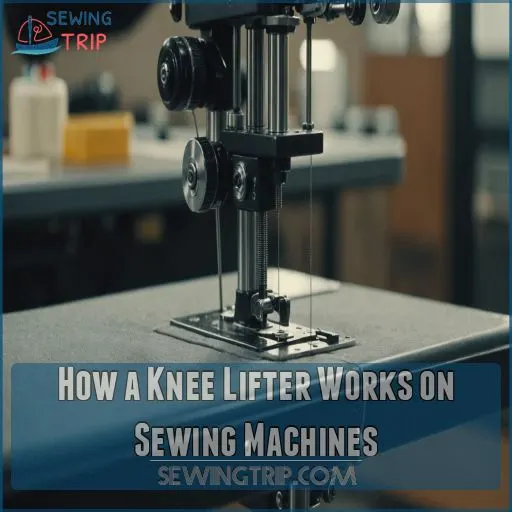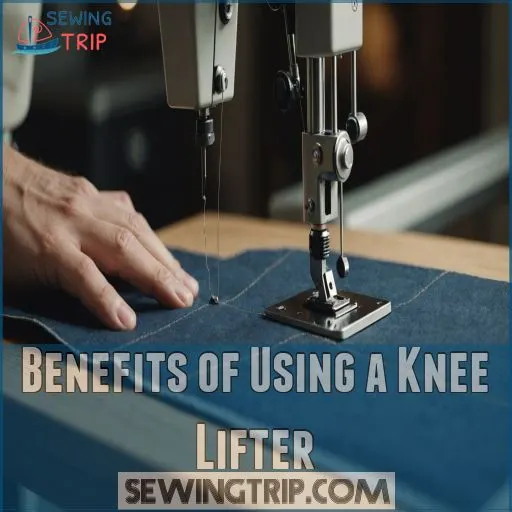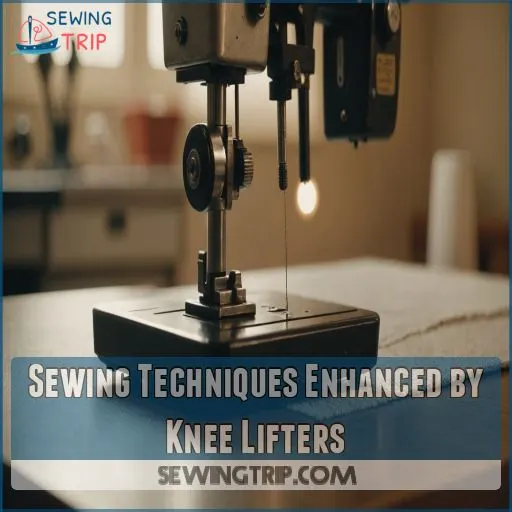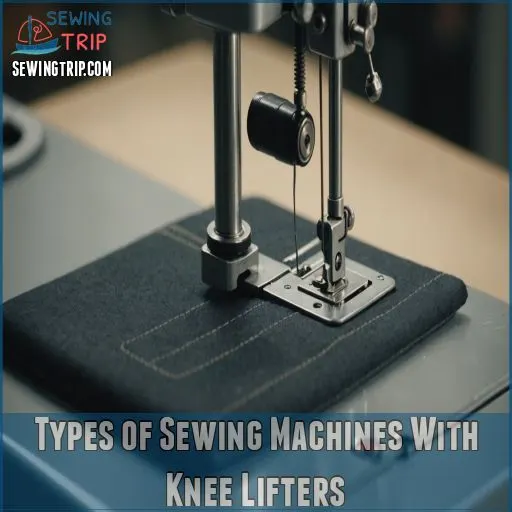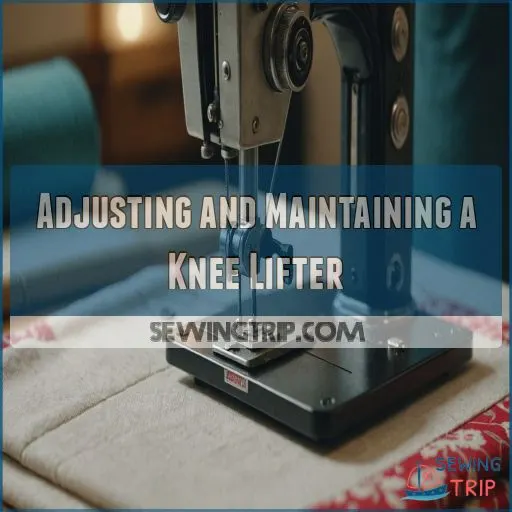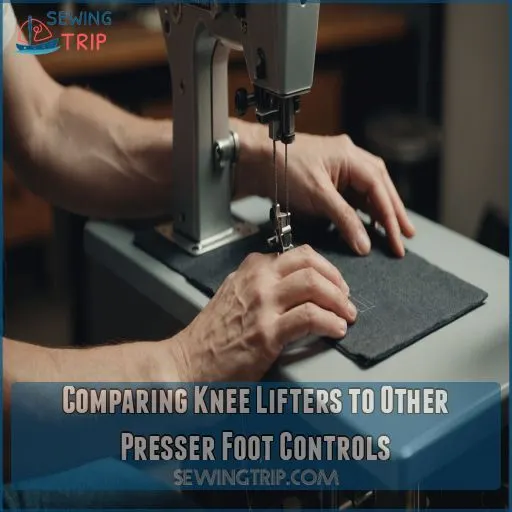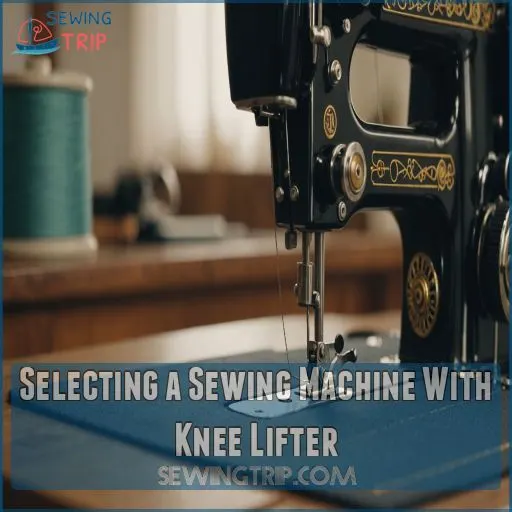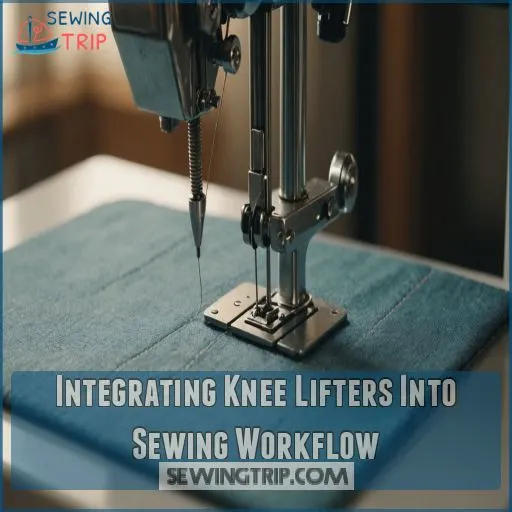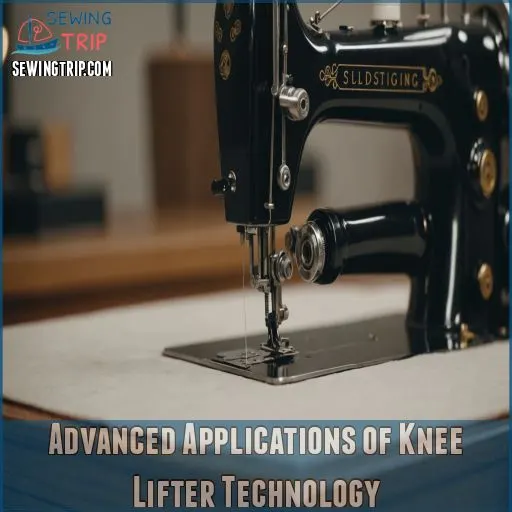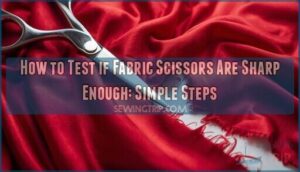This site is supported by our readers. We may earn a commission, at no cost to you, if you purchase through links.
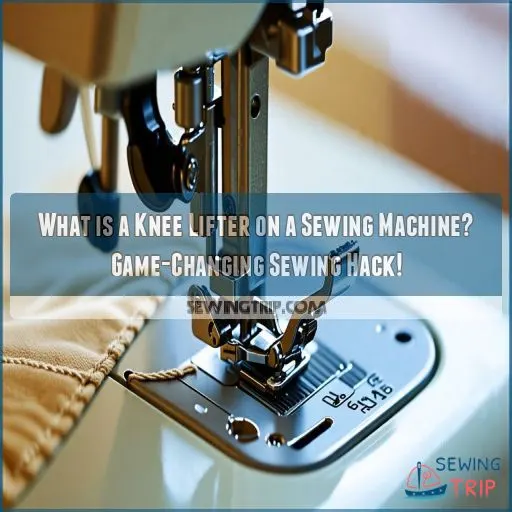
Think of it as the multitasker’s dream come true, especially on high-end machines. By connecting to the presser bar, the knee lifter lets you pivot corners and master the fabric flow without breaking a sweat.
You’ll find it’s perfect for tasks like free-motion quilting. Want to sew like a pro without the arm strain? The knee lifter’s got your back—or rather, your knee!
Curious how it transforms tricky sewing challenges? With the knee lifter, you can accomplish this with ease, making it the multitasker’s dream come true. The knee lifter is indeed the sew like a pro solution you’ve been looking for.
Table Of Contents
- Key Takeaways
- Definition and Purpose of a Knee Lifter
- How a Knee Lifter Works on Sewing Machines
- Benefits of Using a Knee Lifter
- Sewing Techniques Enhanced by Knee Lifters
- Types of Sewing Machines With Knee Lifters
- Adjusting and Maintaining a Knee Lifter
- Comparing Knee Lifters to Other Presser Foot Controls
- Selecting a Sewing Machine With Knee Lifter
- Integrating Knee Lifters Into Sewing Workflow
- Advanced Applications of Knee Lifter Technology
- Frequently Asked Questions (FAQs)
- Conclusion
Key Takeaways
- Your knee’s new best friend: A knee lifter frees up your hands, letting you guide fabric like a pro while effortlessly controlling the presser foot. It’s like having an extra set of hands, minus the awkward high-fives.
- Sewing at warp speed: With a knee lifter, you’ll zip through projects faster than a caffeinated hare. It’s perfect for pivoting corners, free-motion quilting, and handling multiple fabric layers without breaking a sweat.
- Ergonomic bliss: Say goodbye to hand cramps and hello to longer, more comfortable sewing sessions. Your wrists will thank you for choosing a machine with this nifty feature.
- Not just for the pros: While common in high-end machines, knee lifters are becoming more accessible. You’ll find them in various models, from industrial workhorses to user-friendly domestic machines. It’s like upgrading from a flip phone to a smartphone – once you try it, you’ll wonder how you ever lived without it.
Definition and Purpose of a Knee Lifter
A knee lifter is a hands-free control on your sewing machine that raises and lowers the presser foot, allowing for easy presser foot adjustment
.
You’ll find this time-saving feature on high-end machines.
Allowing you to keep your hands on your fabric while adjusting the presser foot with a simple knee movement is a benefit of using a knee lifter on your sewing machine, which is a hands-free control.
Hands-Free Presser Foot Control
Ever felt like you needed an extra hand while sewing? Enter the knee lifter, your new best friend for hands-free presser foot control. This nifty device lets you lift and lower the presser foot with a simple knee movement, freeing up your hands for fabric manipulation.
Here’s what it does:
- Lifts the presser foot
- Releases thread tension
- Drops the feed dog
Say goodbye to awkward hand movements and hello to smoother sewing. It’s like having a third hand, but better!
Connection to Presser Bar
How does a knee lifter connect to your sewing machine’s presser bar? It’s all about the clever linkage design. The knee lifter mechanism attaches directly to the presser bar, allowing you to raise and lower it hands-free.
Here’s a quick breakdown of the components involved:
| Component | Function | Maintenance |
|---|---|---|
| Linkage | Transfers motion | Regular lubrication |
| Spring | Provides tension | Check for wear |
| Adjustment screw | Fine-tunes movement | Periodic tightening |
This connection gives you precise control over fabric manipulation, making your sewing smoother than butter on a hot skillet.
Alternative to Manual Presser Foot Lever
The knee lifter offers a hands-free alternative to the manual presser foot lever, giving you more control over your sewing projects.
Connected to the presser bar, this nifty gadget lets you raise and lower the presser foot with a gentle nudge of your knee.
It’s like having an extra set of hands, freeing yours to guide fabric precisely.
Say goodbye to hand fatigue and hello to smoother sewing sessions!
Common Feature in High-End Sewing Machines
You’ll find knee lifters as a common feature in high-end sewing machines.
This hands-free tool lets you control the presser foot without taking your hands off your fabric.
It’s a game-changer for precision work like pivoting corners or free-motion quilting.
Many industrial and top-tier domestic machines offer this feature, giving you more control and efficiency in your sewing projects, making it a precision work tool.
How a Knee Lifter Works on Sewing Machines
You’ll find the knee lifter connected to your sewing machine’s presser bar, allowing you to raise and lower the presser foot with a gentle push of your knee.
This clever mechanism frees up your hands, letting you smoothly guide fabric while maintaining precise control over your stitching.
Mechanical Linkage to Presser Foot
Ever wondered about the magic behind a knee lifter? It’s all in the mechanical linkage. This clever system connects your knee movements to the presser foot, giving you hands-free control.
Here’s how it works:
- A lever extends from the machine’s body
- This lever connects to the presser bar via a series of rods and joints
- When activated, it lifts the presser foot, allowing for easy fabric manipulation
Think of it as your sewing sidekick, ready to lift that foot at a moment’s notice!
Activation Through Knee Pressure
Activating your knee lifter is as easy as pie.
Just give it a gentle nudge with your knee, and watch the magic happen. Your presser foot lifts, thread tension releases, and feed dogs drop, all in one smooth motion.
It’s like having an extra pair of hands! With practice, you’ll develop muscle memory, making this game-changing hack second nature.
Say goodbye to hand fatigue and hello to seamless sewing control.
Adjustable Positioning for Comfort
The ergonomic design of a knee lifter allows for custom positioning to fit your body.
You can adjust its height and angle for maximum comfort during long sewing sessions. This personalized setup reduces strain and fatigue, letting you focus on your projects.
Whether you’re tackling free-motion quilting or working with thick fabrics, the adjustable knee pad makes sure you’re always in control. It’s like having a sewing buddy that knows just how you like things!
Quick Release and Return Mechanism
You’ll love how the quick release and return mechanism works on your knee lifter. It’s like having a secret superpower for your sewing machine!
Here’s how it functions:
- Spring-loaded tension keeps the presser foot down
- Your knee pressure overcomes the spring, lifting the foot
- Release your knee, and the spring snaps the foot back down
This lightning-fast action lets you pivot fabric, adjust positioning, and keep your hands free for precise control. It’s a game-changer for your sewing workflow!
Benefits of Using a Knee Lifter
You’ll love the benefits a knee lifter brings to your sewing projects.
It boosts your speed and precision while reducing hand strain.
Letting you focus on creating beautiful, professional-looking pieces with ease.
Increased Sewing Speed and Efficiency
Now that you understand how a knee lifter works, let’s explore its speed-boosting magic.
With this nifty tool, you’ll zip through projects like a seasoned pro. It’s all about keeping your hands where they belong – on your fabric.
Check out this table showing how a knee lifter can turbocharge your sewing:
| Task | Without Knee Lifter | With Knee Lifter |
|---|---|---|
| Chain Piecing | Stop and start | Continuous flow |
| Quilting | Frequent pauses | Smooth sailing |
| Pivoting | Hand juggling act | Effortless turns |
| Overall Speed | Tortoise | Hare on caffeine |
Improved Fabric Control and Manipulation
Imagine this: you’re guiding delicate silk through your machine, and suddenly, you need to adjust its position.
With a knee lifter, you’re in control. It allows for precise fabric feeding and smooth movement, even with layered materials.
You’ll manipulate corners and curves effortlessly, maintaining even tension throughout. It’s like having an extra set of hands, giving you the power to handle fabric with finesse and confidence.
It enables you to maintain control over your work, making the process easier and more enjoyable, allowing you to work with even tension throughout.
Reduced Hand Fatigue and Strain
Moving from improved fabric control, the knee lifter greatly reduces hand fatigue and strain. By tackling repetitive motions, it aids ergonomics and promotes better sewing posture. This minimizes common issues like hand pain, carpal tunnel, and the need for wrist support. Imagine less discomfort and more leisure in your sewing projects.
- Say goodbye to hand cramps!
- Enjoy longer sewing sessions.
- Protect your wrists from overuse.
- Experience newfound comfort while crafting.
Enhanced Precision in Delicate Work
After reducing hand fatigue, the knee lifter shines in tasks requiring precision. You can handle delicate fabric, make precise buttonholes, and achieve fine appliqué with ease. Embroidery accuracy improves as well, allowing beadwork techniques to be executed smoothly.
By freeing your hands, the knee lifter allows you to focus on crafting those intricate details perfectly. This hands-free control can be a valuable tool for various sewing tasks, especially for beginners who may not have the same level of dexterity and control with a foot pedal.
Some older sewing machines, like those made by Singer and Bernina, utilize a knee press for hands-free sewing, which is similar to the function of a knee lifter.
You can learn more about alternative control methods for sewing machines.
Sewing Techniques Enhanced by Knee Lifters
With a knee lifter, you can easily tackle sewing techniques like pivoting corners, creating smoother curves, and handling multiple fabric layers.
It also enhances your precision in free-motion quilting and embroidery, making intricate work less challenging.
Pivoting Corners and Curves
One handy way to pivot around corners and curves is to lift the presser foot just enough to maneuver the fabric.
Avoid lifting it too high, which can release the top tension. Instead, use small adjustments, pivoting the piece as you go.
This technique takes practice, but it’s essential for achieving smooth, professional-looking results on curved seams and appliqué projects.
Free-Motion Quilting and Embroidery
Consider using a knee lifter to make free-motion quilting and embroidery a breeze. You’ll gain control over complex quilting designs and embroidery with precise movements.
Combine this with mastering embroidery thread choices and stabilizer selection for flawless results. A combination sewing and embroidery machine, like the Brother SE600 with 103 built-in stitches and 80 embroidery designs, can also greatly enhance your free-motion quilting and embroidery experience sewing and embroidery machine.
Don’t forget hooping techniques to maintain fabric tension—your creative projects won’t just look good; they’ll be a stitch above the rest!
Appliqué and Decorative Stitching
Picture yourself mastering appliqué techniques with ease.
A knee lifter transforms your sewing by offering hands-free control, letting you pivot seamlessly when creating intricate decorative stitch patterns.
Choose compatible fabric, make sure you select the right thread, and adjust machine settings for flawless results.
Enjoy enhanced precision and creative freedom, as the knee lifter helps keep your hands on the fabric, not the presser foot.
Working With Multiple Fabric Layers
When working with multiple fabric layers, a knee lifter is your best friend.
It helps manage fabric thickness, ensuring even feed and proper quilt sandwich alignment.
This hands-free control lets you adjust the presser foot height smoothly, which aids in precise piecing techniques.
Say goodbye to shifting layers and hello to sewing mastery without the fuss!
Types of Sewing Machines With Knee Lifters
You’ll find knee lifters on a variety of machines, from industrial models to high-end domestic ones.
They are also found on quilting-specific machines and advanced computerized systems, making sewing more efficient.
Industrial and Commercial Grade Models
Industrial and commercial grade sewing machines, like those from Juki and Janome, often include knee lifters for greater control and efficiency.
These machines excel in durability, handling demanding tasks with ease.
When choosing between models, consider knee lift features, price differences, and maintenance needs.
Keep your machine in top shape by regularly cleaning and lubricating key parts.
High-End Domestic Sewing Machines
High-end domestic sewing machines featuring knee lifters offer seamless hands-free control, providing you with enhanced sewing efficiency and precision, especially with machines offering alternative control options like computerized machine controls
.
You’ll find top brands praised in reviews for their reliable features and user-friendly designs.
- Features: Advanced knee lifter systems
- Price: Varies across brands
- Brands: Bernina, Juki, Brother
- Maintenance: Regular cleaning and checks for smooth operation
Quilting-Specific Machines
Quilting-specific machines often feature a handy knee lifter, allowing you to raise and lower the presser foot hands-free.
This game-changing feature boosts efficiency, especially for intricate quilting techniques like free-motion stitching and handling bulky fabric layers.
With a responsive knee lift, you’ll enjoy improved control, reduced hand fatigue, and the ability to pivot corners with precision.
Computerized Vs. Mechanical Knee Lifter Systems
While quilting-specific machines offer specialized functions, exploring computerized vs. mechanical knee lifter systems reveals key differences.
- Accuracy and Customization: Computerized systems provide precise adjustments, enhancing your sewing precision.
- Reliability and Cost: Mechanical systems are durable and typically cost-effective.
- Maintenance: Computerized options need regular updates; mechanical ones require basic upkeep.
Choose based on your sewing goals, balancing needs with budget.
Adjusting and Maintaining a Knee Lifter
To keep your knee lifter working smoothly, make sure it’s positioned correctly for comfort and lubricate any moving parts regularly.
Regularly inspect it for wear and tear, addressing any issues promptly to maintain its efficiency.
Proper Positioning for Ergonomic Use
Finding the right knee lift height for your sewing machine is like achieving that sweet spot—comfort is key.
Adjust your leg positioning to make sure you have effortless back support, and consider a footrest placement for added stability.
Make necessary comfort adjustments to keep sewing enjoyable.
You’ll stitch away with ease, like a maestro conducting a symphony of threads.
Lubricating Moving Parts
After you’ve perfected the position, tackle the knee lifter’s lubrication.
Regularly oiling moving parts keeps your machine running smoothly. Use sewing machine oil for DIY lubrication, avoiding belts which cause slippage. Consider using a fine-grade oil with no additives, like Tri-Flow, to prevent varnish buildup.
Apply oil to key areas, just like you’d when oiling and lubricating your sewing machine’s bobbin housing unit maintenance, shuttle hook, and hook race
. Stick to a maintenance schedule, ensuring each nook is oiled to prevent common problems.
When in doubt, opt for professional servicing over guesswork.
Checking for Wear and Tear
Maintaining your knee lifter extends its lifespan and keeps your sewing flowing smoothly.
After setting up a lubrication schedule, inspect for wear and tear. Watch for stiffness or uneven movements, which might signal common failures.
Regular checks can pinpoint issues early. If something’s amiss, consider replacement parts or a DIY repair to restore top performance (Source).
Troubleshooting Common Issues
When the knee lifter sticks or becomes unresponsive, check for obstructions and lubricate moving parts.
If foot pedal issues arise, calibrate the knee lift to match your sewing comfort, ensuring proper use of the troubleshooting foot pedals
.
Address unresponsiveness with adjustments, and consider lever replacement if necessary.
Don’t let wear and tear catch you off guard; keep your knee lifter in excellent shape (Source).
Comparing Knee Lifters to Other Presser Foot Controls
Wondering how a knee lifter compares to other presser foot controls?
While a manual lever requires your hands, a knee lifter lets you raise and lower the presser foot with just a tap of your knee.
A game-changer for complex sewing projects.
Knee Lifter Vs. Manual Lever
Imagine you’re juggling fabric and need both hands on deck.
A knee lifter offers ergonomic benefits, boosting sewing speed and precision control compared to a manual lever.
You’ll feel it in repetitive tasks: sewing becomes smoother, less of a circus act.
While knee lifters have a learning curve, they’re suitable for projects that demand precision and speed.
Knee Lifter Vs. Electronic Foot Control
Switching gears to knee lifter versus electronic foot control, the knee lifter offers hands-free precision and ergonomic benefits. It reduces hand fatigue and allows quick presser foot adjustments, but comes with a steeper learning curve.
When working with various presser feet, such as those designed for installing zippers, mastering the knee lifter’s operation can greatly enhance the sewing experience.
Additionally, understanding how to properly change and adjust presser feet, including adjusting the presser foot pressure, is essential for getting the best results
.
Electronic foot controls, though easier to master, may sacrifice some control. Balancing cost and your sewing projects helps decide the best fit.
Advantages in Complex Sewing Projects
Complex sewing projects often demand agility.
A knee lifter gives you an edge for fabric manipulation by letting hands focus on precision quilting or intricate appliqué.
While adjusting layers during garment construction, you maintain multi-layer management in check.
Compared to foot controls, a knee lifter promotes efficiency, reducing hand fatigue and enhancing precision, especially on tight curves.
Learning Curve and Adaptation Period
Working on complex projects highlights the need for precision, and using a knee lifter requires building muscle memory.
You might experience initial discomfort, but practice drills can help.
Adjust your machine for an ergonomic setup, ensuring smooth operation.
Unlike traditional foot controls, mastering the knee lifter involves a unique coordination skill set, streamlining your sewing process over time (Source).
Selecting a Sewing Machine With Knee Lifter
When selecting a sewing machine with a knee lifter, focus on your specific sewing needs.
Like quilting or garment construction, consider the specific tasks you will be using the machine for.
Consider the machine’s build quality and knee lifter responsiveness to make sure it meets your budget.
And enhances your sewing experience.
Assessing Your Sewing Needs
To choose a sewing machine with a knee lifter, evaluate your sewing projects, budget constraints, and experience.
Whether you’re tackling thick fabric types or delicate stitches, the machine features must align with your needs.
Consider how often you sew and your project types, ensuring the knee lifter enhances efficiency.
Balancing your budget and functionality is key for the best fit.
Considering Machine Build Quality
When choosing a sewing machine with a knee lifter, consider the build quality.
Look for a durable machine from a reputable brand, with high-quality materials and sturdy construction features.
A well-made machine will provide years of smooth, consistent performance, making sewing a breeze.
Check user reviews to gauge long-term reliability.
Evaluating Knee Lifter Responsiveness
Feeling the knee lift sensitivity is like knowing your dance partner’s every move.
Evaluate the pedal pressure impact for effortless control. Compare lift speed and smoothness of action between models.
A good feedback mechanism makes for seamless operation, letting you glide through projects with grace.
Keep an eye on these factors when choosing your next sewing partner.
Budget Considerations for Advanced Features
Balancing knee lifter responsiveness with budget may seem like walking a tightrope. Weigh your investment with cost versus benefit.
Entry-level alternatives offer value for money without breaking the bank. Secondhand options might provide advanced features at a lower price.
Consider feature trade-offs to make sure your machine meets essential needs efficiently.
- Value for money
- Cost vs. benefit
- Feature trade-offs
- Secondhand options
Integrating Knee Lifters Into Sewing Workflow
Integrating knee lifters into your sewing workflow can improve speed and precision by developing muscle memory and coordinating hand and knee movements.
By adapting your existing techniques, you’ll maximize efficiency in production sewing.
Ensuring seamless operation.
Developing Muscle Memory
Mastering the knee lifter requires consistent practice, leading to seamless coordination. Work on repetition to train your muscle memory, gradually making movements instinctive.
You should welcome feedback and adjust techniques as needed. Over time, you’ll see improvements in efficiency and control, transforming your sewing into an art form.
| Key Element | Emotion |
|---|---|
| Practice | Determination |
| Repetition | Confidence |
| Feedback | Empowerment |
Coordinating Hand and Knee Movements
Building muscle memory lays the groundwork for seamlessly coordinating hand and knee movements with your knee lifter.
Engage in practice drills to refine precision control. Focus on foot placement and body mechanics to achieve harmony between limbs.
This dance of motions, like a well-oiled machine, boosts your sewing efficiency and transforms each project into a synchronized masterpiece of hand and knee movements.
Adapting Existing Sewing Techniques
Integrating a knee lifter into your sewing workflow is like having an extra hand, perfect for intricate techniques like free-motion quilting and appliqué.
By adapting your existing skills, such as choosing the right thread type based on the fabric being sewn, you’ll find smoother changes when pivoting corners, crafting buttonholes, or ensuring precise topstitching, especially when working with versatile sharps needles that can handle most small sewing projects.
choosing thread types can also make a big difference in the quality of your work.
Embrace this game-changer and watch your projects reach new heights of precision and ease.
Maximizing Efficiency in Production Sewing
Boost your sewing machine’s knee lifter to streamline your production workflow. This hands-free control lets you quickly raise and lower the presser foot, boosting efficiency in pivoting corners, free-motion stitching, and handling multiple fabric layers. Embrace the convenience and discover new sewing possibilities.
- Enhance fabric control and manipulation
- Reduce hand fatigue and strain
- Improve precision in delicate work
- Increase overall sewing speed and efficiency
Advanced Applications of Knee Lifter Technology
You’re likely to see knee lifter technology aiding complex sewing tasks.
Like combining with dual feed systems for enhanced fabric control, providing better handling of various fabrics.
Sophisticated integrations with computerized stitch selection and its role in industrial processes demonstrate the knee lifter’s evolving capabilities.
Combination With Dual Feed Systems
Curious how dual feed systems enhance your sewing machine’s knee lifter?
Imagine controlling fabric like a dance partner, ensuring every step is precise.
Dual feed benefits let you glide through layers with ease, enhancing fabric control for perfectly aligned seams.
This combo boosts precision sewing and seam consistency, especially in quilting applications, transforming your projects into seamless masterpieces.
Integration With Computerized Stitch Selection
After combining knee lifters with dual feed systems, consider exploring computerized stitch selection. With a knee lifter, you can effortlessly engage digital stitch control.
Imagine using automated stitch selection and stitch memory to streamline your projects.
Custom stitch programming lets your creativity run wild, crafting unique, programmable stitch patterns with ease, allowing you to elevate your sewing mastery by embracing this innovation.
Use in Specialized Industrial Processes
In specialized industrial sewing, knee lifters are game-changers.
They offer hands-free presser foot control, boosting efficiency in fields like leather goods, apparel manufacturing, automotive upholstery, and shoemaking.
By allowing quick fabric adjustments, knee lifters improve precision and speed, making them essential for complex tasks.
This tool is as indispensable as your favorite sewing gadget, driving productivity.
Future Innovations in Knee Lifter Design
Exploring future knee lifter innovations reveals remarkable possibilities.
Imagine incorporating:
- Ergonomic design for effortless use.
- Smart control tailoring functions to your needs.
- Wireless integration letting you move freely.
- AI-powered adjustment adapting to fabric types.
Emphasizing a sustainability focus, these developments promise enhanced sewing experiences, offering user-friendly, tech-savvy solutions that simplify complex tasks, boosting efficiency in any sewing project.
Frequently Asked Questions (FAQs)
What is a knee lift sewing machine?
Did you know a knee lift can improve sewing efficiency by freeing your hands?
This lever, positioned under the sewing machine, lets you lift the presser foot with your knee, enhancing control and reducing fabric handling.
How do knee lifters work?
You operate a knee lifter by pushing your knee against a lever beneath the sewing machine.
This action raises the presser foot, freeing your hands for fabric manipulation.
Enhancing efficiency, and allowing complex stitching maneuvers.
What is a knee lifter used for?
Imagine a painter’s easel holding your canvas steady.
A knee lifter lets you control your sewing machine’s presser foot effortlessly, freeing your hands to work with various sewing machine feet
.
It’s essential for precise fabric manipulation, enhancing sewing efficiency and comfort.
What is a knee lift?
A knee lift on a sewing machine is a lever allowing hands-free control.
By nudging it with your knee, you raise the presser foot, release thread tension, and lower the feed dogs.
This enhances sewing efficiency and precision.
How to use a knee lifter on a sewing machine?
As the saying goes, "practice makes perfect."
Use your knee to gently press the knee lifter, lifting the presser foot.
This keeps your hands free, enhancing convenience and control during sewing projects.
What is a knee lift?
A knee lift, or Free Hand System, lets you raise the presser foot by nudging a lever with your knee.
This feature keeps your hands free for fabric manipulation, enhancing control and efficiency while sewing.
What is knee control on a sewing machine?
The knee control on a sewing machine lets you operate it hands-free, lifting the presser foot or controlling the speed and direction of the stitching.
It’s a convenient feature that frees up your hands for more precise sewing, allowing for better control with the use of hands-free operation.
What sewing machines have a knee lift?
Janome and Juki sewing machines often feature knee lifts, enhancing hands-free fabric manipulation.
This tool, like magic, lifts the presser foot with a simple knee nudge, streamlining sewing tasks for efficiency and precision.
Can a knee lifter be added to any sewing machine?
Imagine upgrading your trusty old sewing machine with a knee lifter. It’s possible, but tough.
Most machines weren’t designed for one.
Consider the Universal Presser Foot Lifter for compatibility.
Consult professionals to avoid damaging your machine.
How do I adjust the sensitivity of my knee lifter?
To adjust your knee lifter’s sensitivity, access the settings menu on your machine.
Look for knee lifter options, then test and tweak the sensitivity until it feels comfortable for your sewing style.
Enjoy smoother stitching control!
Can a knee lifter be used for free-motion quilting?
You can use a knee lifter for free-motion quilting, but it’s not essential.
While it frees up your hands, many quilters prefer controlling the presser foot manually.
Focus on mastering stitch consistency and fabric movement for better results.
What are the downsides of using a knee lifter?
Like a rose with thorns, knee lifters have their pricks.
You’ll grapple with accidental activations, causing wonky stitches.
They’re tricky to rewire and may leave holes in your machine’s base.
Adjusting can be finicky, testing your patience.
How do I clean and maintain my knee lifter?
Regular maintenance keeps your knee lifter in top shape.
Wipe it down with a clean cloth, and apply a drop of sewing machine oil to the joint.
Adjust it periodically for comfort and best performance.
Don’t forget to check for loose screws!
Conclusion
Imagine this: you’re a conductor, and your sewing machine’s the orchestra. The knee lifter? It’s your magic baton.
As you’ve learned, a knee lifter on a sewing machine isn’t just a fancy add-on—it’s your ticket to seamless sewing. It frees your hands, boosts your speed, and turns tricky tasks into a breeze.
Whether you’re quilting, pivoting, or just aiming to up your sewing game, the knee lifter’s got your back. Ready to conduct your fabric symphony? Your knee’s the maestro now!

